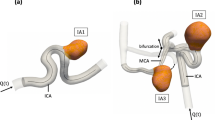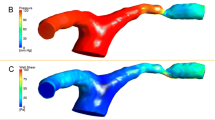Abstract
Purpose
We performed computational fluid dynamics (CFD) for patients with and without paraclinoid internal carotid artery (ICA) aneurysms to evaluate the distribution of vascular biomarkers at the aneurysm initiation sites of the paraclinoid ICA.
Methods
This study included 35 patients who were followed up for aneurysms using 3D time of flight (TOF) magnetic resonance angiography (MRA) and 3D cine phase-contrast MR imaging. Fifteen affected ICAs were included in group A with the 15 unaffected contralateral ICAs in group B. Thirty-three out of 40 paraclinoid ICAs free of aneurysms and arteriosclerotic lesions were included in group C. We deleted the aneurysms in group A based on the 3D TOF MRA dataset. We performed CFD based on MR data set and obtained wall shear stress (WSS), its derivatives, and streamlines. We qualitatively evaluated their distributions at and near the intracranial aneurysm initiation site among three groups. We also calculated and compared the normalized highest (nh-) WSS and nh-spatial WSS gradient (SWSSG) around the paraclinoid ICA among three groups.
Results
High WSS and SWSSG distribution were observed at and near the aneurysm initiation site in group A. High WSS and SWSSG were also observed at similar locations in group B and group C. However, nh-WSS and nh-SWSSG were significantly higher in group A than in group C, and nh-SWSSG was significantly higher in group A than in group B.
Conclusion
Our findings indicated that nh-WSS and nh-SWSSG were good biomarkers for aneurysm initiation in the paraclinoid ICA.






Similar content being viewed by others
References
Connolly ES Jr, Rabinstein AA, Carhuapoma JR, Derdeyn CP, Dion J, Higashida RT, et al (2012) Guidelines for the management of aneurysmal subarachnoid hemorrhage: a guideline for healthcare professionals from the American Heart Association/American Stroke Association. Stroke 43:1711–1737
Shojima M, Oshima M, Takagi K, Torii R, Hayakawa M, Katada K, Morita A, Kirino T (2004) Magnitude and role of wall shear stress on cerebral aneurysm: computational fluid dynamic study of 20 middle cerebral artery aneurysms. Stroke 35:2500–2505
Meng H, Wang Z, Hoi Y, Gao L, Metaxa E, Swartz DD, Kolega J (2007) Complex hemodynamics at the apex of an arterial bifurcation induces vascular remodeling resembling cerebral aneurysm initiation. Stroke 38:1924–1931
Japan Investigators UCAS, Morita A, Kirino T, Hashi K, Aoki N, Fukuhara S et al (2012) The natural course of unruptured cerebral aneurysms in a Japanese cohort. N Engl J Med 366:2474–2482
Malek AM, Alper SL, Izumo S (1999) Hemodynamic shear stress and its role in atherosclerosis. JAMA 282:2035–2042
Markl M, Chan FP, Alley MT, Wedding KL, Draney MT, Elkins CJ, Parker DW, Wicker R, Taylor CA, Herfkens RJ, Pelc NJ (2003) Time-resolved three-dimensional phase-contrast MRI. J Magn Reson Imaging 17:499–496
Isoda H, Ohkura Y, Kosugi T, Hirano M, Takeda H, Hiramatsu H, Yamashita S, Takehara Y, Alley MT, Bammer R, Pelc NJ, Namba H, Sakahara H (2010) In vivo hemodynamic analysis of intracranial aneurysms obtained by magnetic resonance fluid dynamics (MRFD) based on time-resolved three-dimensional phase-contrast MRI. Neuroradiology 52:921–928
Steiger HJ, Liepsch DW, Poll A, Reulen HJ (1988) Hemodynamic stress in terminal saccular aneurysms: a laser-Doppler study. Heart Vessel 4:162–169
Isoda H, Takehara Y, Kosugi T, Terada M, Naito T, Onishi Y et al (2015) MR-based computational fluid dynamics with patient-specific boundary conditions for the initiation of a sidewall aneurysm of a basilar artery. Magn Reson Med Sci 14:139–144
He X, Ku DN (1996) Pulsatile flow in the human left coronary artery bifurcation: average conditions. J Biomech Eng 118:74–82
Shimogonya Y, Ishikawa T, Imai Y, Matsuki N, Yamaguchi T (2009) Can temporal fluctuation in spatial wall shear stress gradient initiate a cerebral aneurysm? A proposed novel hemodynamic index, the gradient oscillatory number (GON). J Biomech 42:550–554
Mantha A, Karmonik C, Benndorf G, Strother C, Metcalfe R (2006) Hemodynamics in a cerebral artery before and after the formation of an aneurysm. AJNR Am J Neuroradiol 27:1113–1118
Dolan JM, Kolega J, Meng H (2013) High wall shear stress and spatial gradients in vascular pathology: a review. Ann Biomed Eng 41:1411–1427
Kulcsár Z, Ugron A, Marosfoi M, Berentei Z, Paál G, Szikora I (2011) Hemodynamics of cerebral aneurysm initiation: the role of wall shear stress and spatial wall shear stress gradient. AJNR Am J Neuroradiol 32:587–594
Geers AJ, Morales HG, Larrabide I, Butakoff C, Bijlenga P, Frangi AF (2017) Wall shear stress at the initiation site of cerebral aneurysms. Biomech Model Mechanobiol 16:97–115
Chen H, Selimovic A, Thompson H, Chiarini A, Penrose J, Ventikos Y, Watton PN (2013) Investigating the influence of haemodynamic stimuli on intracranial aneurysm inception. Ann Biomed Eng 41:1492–1504
Rafiei A, Hafez A, Jahromi BR, Kivisaari R, Canato B, Choque J, Colasanti R, Fransua S, Lehto H, Andrade-Barazarte H, Hernesniemi J (2017) Anatomic features of paraclinoid aneurysms: computed tomography angiography study of 144 aneurysms in 136 consecutive patients. Neurosurgery 81:949–957
Walker PG, Cranney GB, Scheidegger MB, Waseleski G, Pohost GM, Yoganathan AP (1993) Semiautomated method for noise reduction and background phase error correction in MR phase velocity data. J Magn Reson Imaging 3:521–530
Xiang J, Tremmel M, Kolega J, Levy EI, Natarajan SK, Meng H (2012) Newtonian viscosity model could overestimate wall shear stress in intracranial aneurysm domes and underestimate rupture risk. J Neurointerv Surg 4:351–357
Ruopp MD, Perkins NJ, Whitcomb BW, Schisterman EF (2008) Youden Index and optimal cut-point estimated from observations affected by a lower limit of detection. Biom J 50:419–430
Wang Z, Kolega J, Hoi Y, Gao L, Swartz DD, Levy EI, Mocco J, Meng H (2009) Molecular alterations associated with aneurysmal remodeling are localized in the high hemodynamic stress region of a created carotid bifurcation. Neurosurgery 65:169–177
Kolega J, Gao L, Mandelbaum M, Mocco J, Adnan H, Sabareesh K, Siddiqui AH, Natarajan SK, Meng H (2011) Cellular and molecular responses of the basilar terminus to hemodynamics during intracranial aneurysm initiation in a rabbit model. J Vasc Res 48:429–442
Meng H, Metaxa E, Gao L, Liaw N, Natarajan SK, Swartz DD, Siddiqui AH, Kolega J, Mocco J (2011) Progressive aneurysm development following hemodynamic insult. J Neurosurg 114:1095–1103
Meng H, Tutino VM, Xiang J, Siddiqui A (2014) High WSS or low WSS? Complex interactions of hemodynamics with intracranial aneurysm initiation, growth, and rupture: toward a unifying hypothesis. AJNR Am J Neuroradiol 35:1254–1262
Acknowledgments
We thank Marcus T. Alley, PhD, for allowing us to use 3D cine PC MRI developed at Stanford University.
Author information
Authors and Affiliations
Corresponding author
Ethics declarations
Funding
This study was funded by the JSPS KAKENHI (Japan Society for the Promotion of Science, Grants-in-Aid for Scientific Research) (Grant Number 25293264).
Conflict of interest
Takafumi Kosugi is an employee of Renaissance of Technology Corporation, Hamamatsu, Japan.
Ethical approval
All procedures performed in studies involving human participants were in accordance with the ethical standards of the institutional and/or national research committee and with the 1964 Helsinki declaration and its later amendments or comparable ethical standards.
Informed consent
Informed consent was obtained from all individual participants included in the study.
Rights and permissions
About this article
Cite this article
Watanabe, T., Isoda, H., Takehara, Y. et al. Hemodynamic vascular biomarkers for initiation of paraclinoid internal carotid artery aneurysms using patient-specific computational fluid dynamic simulation based on magnetic resonance imaging. Neuroradiology 60, 545–555 (2018). https://doi.org/10.1007/s00234-018-2002-8
Received:
Accepted:
Published:
Issue Date:
DOI: https://doi.org/10.1007/s00234-018-2002-8




